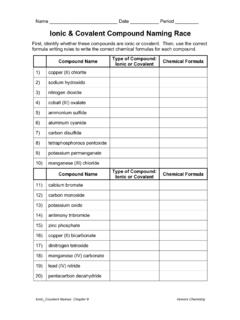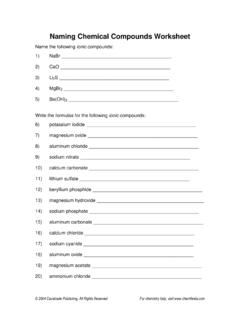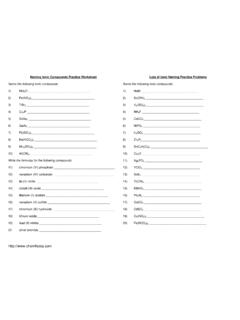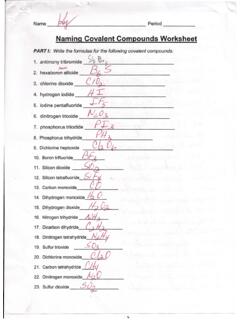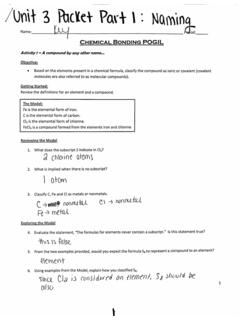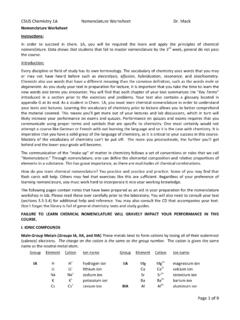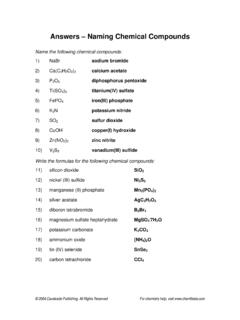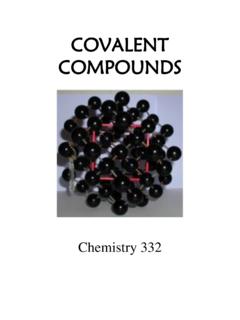Transcription of Covalent Bonding
1 Name Class Date Covalent Bonding Bonding , Interactions, and naming Compounds For students using the Foundation edition, Molecular Compounds assign problems 1 11. Essential Understanding Ionic and molecular compounds can both be represented by formulas, but contain different types of Bonding and representative units. Reading Strategy Frayer Model The Frayer Model is a vocabulary development tool. The center of the diagram shows the concept being defined, while the quadrants around the concept are used for providing the details. Use this model when you want to understand a vocabulary term in more detail. As you read Lesson , use the Frayer Model below to better understand the word molecule. Definition in your own words Facts/characteristics group of atoms that bonds by can be two of the same atom or sharing electrons and has no charge atoms of different elements held together by Covalent bonds molecule Examples Nonexamples H2O, CO2, O2, NH3 NaCl, NaOH.
2 EXTENSION Create a Frayer Model for each of the terms Covalent bond, diatomic molecule, molecular compound , and molecular formula. Lesson Summary Molecules and Molecular Compounds The electrons in a molecular compound are shared. The atoms in a molecular compound are held together by Covalent bonds. Molecular compounds can be represented by molecular formulas, which tell how many of each type of atom are in the compound . Lesson Reading and Study Workbook Copyright Pearson Education, Inc., or its affiliates. All Rights Reserved. 96. Name Class Date Types of Molecular Compounds Diatomic More than one element H2, O2, N2, Cl2 H2O, NH3, C2H6O. Comparing Molecular and Ionic Compounds Unlike ionic compounds, molecular compounds have no charge and are held together by Covalent bonds. The formula for a molecular compound describes the combination of atoms that make up one molecule.
3 The formula for an ionic compound describes a ratio of ions in the compound . After reading lesson , answer the following questions. Molecules and Molecular Compounds 1. What is a Covalent bond? A Covalent bond is a bond formed when two atoms share electrons. 2. Many elements found in nature exist as molecules . 3. What is a molecule? A molecule is a neutral group of atoms joined together by Covalent bonds. 4. Compounds that are formed when two or more atoms combine to form molecules are called molecular compounds . 5. Circle the letter of the substances that do NOT exist as molecules in nature. a. oxygen d. ozone b. water e. helium c. neon 6. List two general properties of molecular compounds. a. low melting and boiling points b. exist as gases or liquids at room temperature 7. What is a molecular formula? A molecular formula shows how many atoms of each element a molecule contains.
4 Match each compound with its molecular formula. c 8. carbon dioxide a. C2H6O. a 9. ethanol b. NH3. b 10. ammonia c. CO2. Lesson Reading and Study Workbook Copyright Pearson Education, Inc., or its affiliates. All Rights Reserved. 97. Name Class Date 11. Is the following sentence true or false? A molecular formula shows the arrangement of the atoms in a molecule. false In the diagram, match the type of model or formula with its representation. a. ball-and-stick drawing d. space-filling molecular model b. molecular formula e. structural formula c. perspective drawing N. NH3(g) H H. N. b 12. _____ H. H H c 15. _____. H. N. d 14. _____ H N H. H H. H H. a 13. _____ 16. e _____. 17. What term describes the arrangement of atoms within a molecule? molecular structure Comparing Molecular and Ionic Compounds 18. How do the formulas differ for molecular and ionic compounds?
5 The formula for a molecular compound represents the atoms that make up one molecule of the compound . The formula for an ionic compound represents one formula unit of the compound . The Nature of For students using the Foundation edition, Covalent Bonding assign problems 2, 4, 5, 8, 10, 11, 14. Essential Understanding Covalent bonds form when atoms share electrons. Reading Strategy Cluster Diagram Cluster diagrams help you know how concepts are related. Write the main idea or topic on a sheet of paper. Circle it. Draw lines branching off the main idea, connected to circles that contain concepts related to the main concept. Continue adding facts and details to the branches. Lesson Reading and Study Workbook Copyright Pearson Education, Inc., or its affiliates. All Rights Reserved. 98. Name Class Date As you read Lesson , use the cluster diagram below to show how each section of the lesson relates to Covalent Bonding .
6 Add circles if necessary. 1, 2, or 3. bonds octet rule hybrid bonds resonance coordinate structures Covalent Covalent Bonding more bonds, higher energy bond dissociation energies strong exceptions bond high energy EXTENSION Draw a cluster diagram for each type of bond. Lesson Summary The Octet Rule in Covalent Bonding Covalent compounds are most stable when each atom has eight electrons. Single, double, and triple Covalent bonds depend on the number of pairs of electrons shared between two atoms. Atoms form double or triple Covalent bonds if they can attain a noble gas structure by doing so. Type of Covalent Bond Attributes One shared electron pair with one electron from Single each atom Two shared electron pairs with two electrons Double from each atom Three shared electron pairs with three electrons Triple from each atom Coordinate Covalent Bonds In a coordinate Covalent bond, one atom contributes both electrons in the Bonding pair.
7 One atom may contribute a pair of unshared electrons to a bond to give both atoms an inert gas configuration. Coordinate Covalent bonds can also occur in polyatomic ions, such as NH4+. Exceptions to the Octet Rule Some molecules have fewer, or more, than a complete octet of valence electrons. Molecules that have an odd number of total valence electrons cannot satisfy the octet rule. Some molecules that have an even number of valence electrons may also fail to follow the octet rule. Lesson Reading and Study Workbook Copyright Pearson Education, Inc., or its affiliates. All Rights Reserved. 99. Name Class Date Bond Dissociation Energies The energy needed to break a Covalent bond depends on the strength of the bond. A large bond dissociation energy corresponds to a strong Covalent bond. Double and triple bonds are stronger than single bonds.
8 Reactivity is linked to the strength or weakness of the Covalent bonds. Resonance The Bonding in some molecules is a blend of several valid electron dot structures. The possible electron dot structures are called resonance forms. Electron pairs do not move back and forth between resonance forms. After reading Lesson , answer the following questions. The Octet Rule in Covalent Bonding 1. What usually happens to the electron configuration of an atom when it forms a Covalent bond? The atom acquires the electron configuration of a noble gas. 2. Is the following sentence true or false? In a structural formula a shared pair of electrons is represented by two dashes. false 3. Structural formulas show the arrangement of atoms in molecules. 4. Use the electron dot structure below. Circle each unshared pair of electrons in a water molecule.
9 O H. H. 5. Complete the electron dot structure for each molecule. Each molecule contains only single Covalent bonds. H H H. N H O O H C H. H H H. a. NH3 b. H2O2 c. CH4. 6. A chemical bond formed when atoms share two pairs of electrons is called a(n). double Covalent bond . Lesson Reading and Study Workbook Copyright Pearson Education, Inc., or its affiliates. All Rights Reserved. 100. Name Class Date 7. How many Covalent bonds are in a nitrogen molecule? three 8. Is the following sentence true or false? All diatomic molecules contain double bonds. false Coordinate Covalent Bonds 9. What is a coordinate Covalent bond? It is a Covalent bond in which one atom contributes both Bonding electrons. 10. Look at Table Which nitrogen compounds contain coordinate Covalent bonds? nitrogen dioxide, dinitrogen tetroxide, and nitrous oxide 11.
10 Complete the electron dot structure for the chlorate ion (ClO3 ) by filling in the bonds and unpaired electrons.. O Cl O. O. Exceptions to the Octet Rule 12. Why does the NO2 molecule not follow the octet rule? There is an unpaired electron present in both possible resonance structures. Bond Dissociation Energies 13. What is bond dissociation energy? Bond dissociation energy is the energy required to break the bond between two covalently bonded atoms. 14. Is the following sentence true or false? Molecules with high bond dissociation energies are relatively unreactive. true 15. What is the bond dissociation energy for a typical C C Covalent bond? 347 kJ/mol Resonance 16. The actual Bonding in ozone is a hybrid of the extremes represented by its resonance forms . Lesson Reading and Study Workbook Copyright Pearson Education, Inc.

